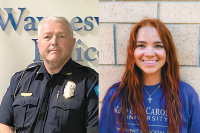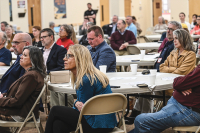Words on the wind: New Cherokee youth radio program offers students a chance to record and broadcast news reports, tribal culture and local history
By Michael Beadle
It’s Thursday morning and Cherokee High School junior Brandi Oocumma is preparing to read a news story on the radio about the risks and benefits of caesarian deliveries. She wants to become a pediatrician one day, so she likes reading articles about children’s issues.
But it can be a little unnerving hearing your own voice over a recording, so Oocumma has been practicing her pronunciation and the pace of her words.
“I think it makes me sound more country,” she says of her radio voice.
Once a week, her teacher, Kevin Norris, brings Oocumma and other academically gifted students in the Horizons program at Cherokee High School across the street to the Cherokee Youth Center to record news stories taken from the Cherokee One Feather. Merritt Youngdeer, who directs the new Cherokee Youth in Radio program at the center, tapes each student separately inside the studio booth and edits the students’ stories during the week. The stories are then uploaded to a website and downloaded to Western Carolina University’s WWCU Power 90.5 FM to be broadcast for a half-hour Saturday morning show that begins at 8:30 a.m.
Although Cherokee doesn’t get radio reception for WWCU, the radio program is on the Internet, thanks to MP3 technology and funding help from the Cherokee Preservation Foundation, which recently gave $70,000 to the radio program.
Related Items
The first broadcast of the Cherokee Youth in Radio program — known in the Cherokee language as “Eastern Cherokee Youth with Words on the Wind” — was on March 4 after three years of a grassroots effort. Those who played a part in the project included Cherokee leaders, school board members community groups, the Cherokee Youth Center, Western Carolina University and tireless efforts from Jackie Stringer, who helped establish similar Native American youth programs across the country such as the Rez Radio show at KFAI in Minneapolis.
The Cherokee students have access to state-of-the-art sound and editing equipment in a professional quality radio studio where Youngdeer records a variety of short and long radio stories for the half-hour program. The computer-editing program allows him to edit out any mistakes from the students — stumbles over words or phrases that might happen to anyone. Only 15 seconds had to be edited out of the 30-minute show two weeks ago. Not bad for a new bunch of radio reporters, admits Youngdeer.
“This is so much better, I tell you,” he said after finishing a brief editing session last week. “I think they’re getting there.”
For Norris and his students, Cherokee Youth in Radio is a great opportunity to develop communication skills and keep up with local news. It’s also a chance to broadcast the Cherokee language. Greg Smith, another Cherokee student radio reporter in Norris’ class, reads and translates Cherokee from Chief Michell Hicks’ reports for the radio.
Students might otherwise be shy about getting up in front of an audience and giving a speech, but broadcasting over the radio only requires speaking into a microphone with another person recording. Even though the radio audience is much larger, there’s less of an embarrassment factor if you make a mistake in the studio.
“Many, many radio people are very shy people,” said Don Connelly, director of broadcasting at WCU and faculty advisor for WWCU. The studio booth allows people to open up in a less intimidating environment.
“I’m very impressed with what Merritt [Youngdeer] and the students have created,” Connelly said, “They’re very well prepared.”
The youth radio program partly grew out of a collaboration between Western Carolina University and the Cherokee One Feather. The way Youngdeer explains it, Cherokee newspaper’s editor, Joe Martin, was working as a reporter and editor and then broadcasting the stories over the radio at WCU, but with all of Martin’s meetings and newspaper duties, broadcasting got to be too much, so the show was temporarily cancelled. Now WCU gets to broadcast local Cherokee news and Cherokee students gain valuable experience in media literacy.
“It’s a great working relationship,” Connelly said.
In addition to recording the news, Youngdeer teaches the students about journalism (Edmund Burke and the fourth estate) and pronunciation (it’s “news” as in “pews” not “news” as in booze”).
Youngdeer has high hopes for the program’s future, including live student broadcasts, expanded youth programming in the nearby Snowbird community, a series of youth-led interviews of Cherokee World War II veterans, and possibly even a new FM radio station in Cherokee.
“There’s all kinds of things we can do, and really the sky’s the limit,” Youngdeer said. “This is a unique opportunity. This is something they can put on their resume.”
Youngdeer has approached Cherokee Broadcasting Company, which runs radio stations in Robbinsville, about having Cherokee students do public service announcements, commercials and radio segments once a week. A few students have interviewed Cherokee veterans of World War II. The interviews are being recorded on CDs and converted to tapes for Cherokee’s local TV news station, Channel 28. Youngdeer is calling the series “Tsalagi Veterans” and he plans to set up 13 more interviews with youth interviewing veterans — including one with Teesatuskie Lee, a Cherokee elder and former codetalker during World War II. Lee’s great-grandson has been tapped to conduct the interview.
If that’s not enough, Youngdeer is also looking into the possibility of having a low-power FM station in Cherokee that could broadcast local youth radio reports and syndicated Native American programs like “Native American Calling” and “National Native News.”
A 20-year veteran in radio, Youngdeer grew up out West and worked at the CBS radio affiliate in Albuquerque, N.M.; the NBC affiliate in Tulsa, Okla.; and most recently for Clear Channel in Asheville before coming to Cherokee to work with high school students — something he had never done before.
“I was a little nervous,” he said, “but I don’t know what I was nervous about because it’s gone really well.”
Two former storage rooms at the Cherokee Youth Center had to be converted into a meeting room and recording studio. Youngdeer went to work painting, assembling the desks, and setting up the engineering equipment. He’s had to adjust to being a one-person staff after working at radio stations that had 20 people doing all the things he now does by himself. It can be overwhelming at times.
One day at the youth center, he had a pounding headache and told the students he was going to have to head home, but the students begged him to stay and record the program. He did, and somehow his headache passed. That memory stays with him when the days get tough.
“Those kids took that headache away from me,” he said. “It’s been a lot of fun; I’ve enjoyed it.”









